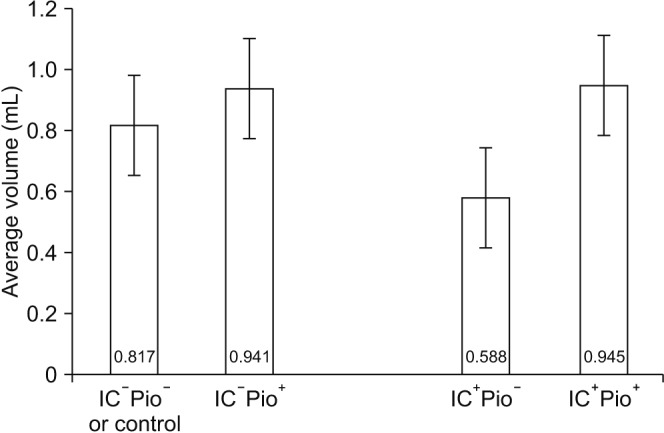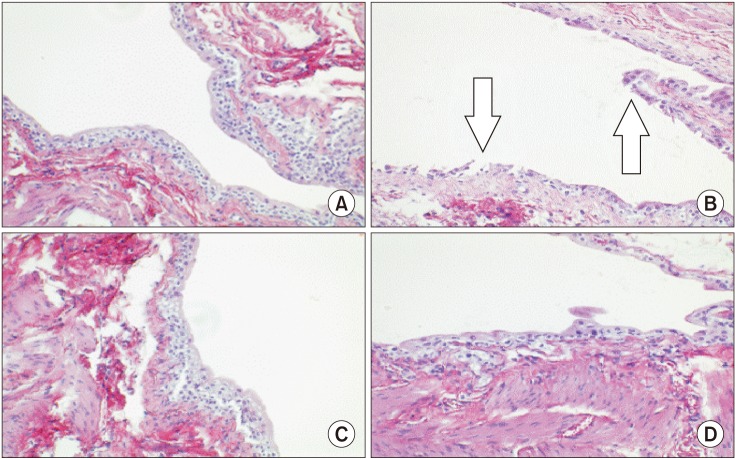Investig Clin Urol.
2018 Jul;59(4):257-262. 10.4111/icu.2018.59.4.257.
Peroxisome proliferator-activated receptor gamma agonist as a novel treatment for interstitial cystitis: A rat model
- Affiliations
-
- 1Division of Urogynecology and Pelvic Reconstructive Surgery, Department of Urology, Stanford University School of Medicine, Stanford, CA, USA. ccomiter@stanford.edu
- 2Division of Urogynecology and Pelvic Reconstructive Surgery, Department of Obstetrics and Gynecology, Stanford University School of Medicine, Stanford, CA, USA.
- KMID: 2414759
- DOI: http://doi.org/10.4111/icu.2018.59.4.257
Abstract
- PURPOSE
To understand the therapeutic potential of pioglitazone, a peroxisome proliferator-activated receptor gamma (PPAR-γ) agonist with a propensity to cause bladder mucosal proliferation, on interstitial cystitis (IC) in a rat model.
MATERIALS AND METHODS
Using a previously described animal model for IC, Sprague-Dawley rats were treated with biweekly cyclophosphamide injections (35 mg/kg) to induce cystitis. Animals were divided into 4 groups (n=6 for each group): IC plus daily sham saline gavage (IC+Pio−), IC plus daily pioglitazone gavage (15 mg/kg) (IC+Pio+), normal rats with daily pioglitazone (IC−Pio+), and normal rats with neither IC nor pioglitazone (IC−Pio− or Control). At the end of four weeks, urinary frequency and bladder capacity were measured. Histologic examination of urothelial integrity was also performed.
RESULTS
Average voids per hour were significantly lower in IC+Pio+ (4.0±1.9) vs. IC+Pio− (10.0±2.4) rats (p<0.01) and were similar to IC−Pio+ (6.0±1.4) and IC−Pio− (6.0±1.5) controls. Cystometric capacity was significantly higher in IC+Pio+ (0.945±0.122 mL) vs. IC+Pio− rats (0.588±0.165 mL, p=0.01) and was comparable to IC−Pio− capacity (0.817±0.196 mL) and IC−Pio+ capacity (0.941±0.188 mL). Urothelial structural integrity was improved in IC+Pio+ rats versus IC+Pio− rats upon histologic observation.
CONCLUSIONS
Pioglitazone, a PPAR-γ agonist, improved bladder function in cyclophosphamide-induced cystitis by both observed urinary frequency and measured cystometric capacity. Urothelial structural integrity was also improved. Pioglitazone, due to a propensity to cause bladder mucosal proliferation, may prove useful for treating IC, and deserves further investigation.
Keyword
MeSH Terms
Figure
Reference
-
1. McLennan MT. Interstitial cystitis: epidemiology, pathophysiology, and clinical presentation. Obstet Gynecol Clin North Am. 2014; 41:385–395. PMID: 25155120.2. Montalbetti N, Rued AC, Taiclet SN, Birder LA, Kullmann FA, Carattino MD. Urothelial tight junction barrier dysfunction sensitizes bladder afferents. eNeuro. 2017; 5. 15. [Epub]. DOI: 10.1523/ENEURO.0381-16.2017.
Article3. Jones CA, Nyberg L. Epidemiology of interstitial cystitis. Urology. 1997; 49(5A Suppl):2–9.
Article4. Chennamsetty A, Khourdali I, Goike J, Killinger KA, Girdler B, Peters KM. Electrosurgical management of Hunner ulcers in a referral center's interstitial cystitis population. Urology. 2015; 85:74–78. PMID: 25440759.
Article5. Keay SK, Birder LA, Chai TC. Evidence for bladder urothelial pathophysiology in functional bladder disorders. Biomed Res Int. 2014; 2014:865463. PMID: 24900993.
Article6. Fry CH, Sahai A, Vahabi B, Kanai AJ, Birder LA. What is the role for biomarkers for lower urinary tract disorders? ICI-RS 2013. Neurourol Urodyn. 2014; 33:602–605. PMID: 24436105.
Article7. Hanno PM, Burks DA, Clemens JQ, Dmochowski RR, Erickson D, Fitzgerald MP, et al. AUA guideline for the diagnosis and treatment of interstitial cystitis/bladder pain syndrome. J Urol. 2011; 185:2162–2170. PMID: 21497847.
Article8. Varley CL, Stahlschmidt J, Lee WC, Holder J, Diggle C, Selby PJ, et al. Role of PPARgamma and EGFR signalling in the urothelial terminal differentiation programme. J Cell Sci. 2004; 117:2029–2036. PMID: 15054105.9. Song PH, Chun SY, Chung JW, Kim YY, Lee HJ, Lee JN, et al. Comparison of 5 different rat models to establish a standard animal model for research into interstitial cystitis. Int Neurourol J. 2017; 21:163–170. PMID: 28954463.
Article10. Suzuki S, Arnold LL, Pennington KL, Kakiuchi-Kiyota S, Wei M, Wanibuchi H, et al. Effects of pioglitazone, a peroxisome proliferator-activated receptor gamma agonist, on the urine and urothelium of the rat. Toxicol Sci. 2010; 113:349–357. PMID: 19858066.
Article11. Nickel JC, Herschorn S, Whitmore KE, Forrest JB, Hu P, Friedman AJ, et al. Pentosan polysulfate sodium for treatment of interstitial cystitis/bladder pain syndrome: insights from a randomized, double-blind, placebo controlled study. J Urol. 2015; 193:857–862. PMID: 25245489.
Article12. Hoke TP, Goldstein H, Saks EK, Vakili B. Hydrodistention of the bladder for the treatment of bladder pain syndrome/interstitial cystitis (BPS/IC). Neurourol Urodyn. 2017; 36:784–786. PMID: 27092957.
Article13. Ko KJ, Chung H, Suh YS, Lee SW, Kim TH, Lee KS. Therapeutic effects of endoscopic ablation in patients with Hunner type interstitial cystitis. BJU Int. 2018; 121:659–666. PMID: 29232035.
Article14. Vij M, Srikrishna S, Cardozo L. Interstitial cystitis: diagnosis and management. Eur J Obstet Gynecol Reprod Biol. 2012; 161:1–7. PMID: 22310942.
Article15. Tung A, Hepp Z, Bansal A, Devine EB. Characterizing health care utilization. Direct costs, and comorbidities associated with interstitial cystitis: a retrospective claims analysis. J Manag Care Spec Pharm. 2017; 23:474–482. PMID: 28345436.
Article16. Inamoto T, Shah JB, Kamat AM. Friend or foe? Role of peroxisome proliferator-activated receptor-gamma in human bladder cancer. Urol Oncol. 2009; 27:585–591. PMID: 19162510.17. Kim A, Han JY, Ryu CM, Yu HY, Lee S, Kim Y, et al. Histopathological characteristics of interstitial cystitis/bladder pain syndrome without Hunner lesion. Histopathology. 2017; 71:415–424. PMID: 28394416.
Article18. Hampp C, Pippins J. Pioglitazone and bladder cancer: FDA's assessment. Pharmacoepidemiol Drug Saf. 2017; 26:117–118. PMID: 28067434.
Article19. Erdmann E, Harding S, Lam H, Perez A. Ten-year observational follow-up of PROactive: a randomized cardiovascular outcomes trial evaluating pioglitazone in type 2 diabetes. Diabetes Obes Metab. 2016; 18:266–273. PMID: 26592506.
Article20. Lewis JD, Habel LA, Quesenberry CP, Strom BL, Peng T, Hedderson MM, et al. Pioglitazone use and risk of bladder cancer and other common cancers in persons with diabetes. JAMA. 2015; 314:265–277. PMID: 26197187.
Article21. Filipova E, Uzunova K, Kalinov K, Vekov T. Pioglitazone and the risk of bladder cancer: a meta-analysis. Diabetes Ther. 2017; 8:705–726. PMID: 28623552.
Article22. Li Z, Sun M, Wang F, Shi J, Wang K. Association between pioglitazone use and the risk of bladder cancer among subjects with diabetes mellitus: a dose-response meta-analysis. Int J Clin Pharmacol Ther. 2017; 55:210–219. PMID: 28025963.23. Birder L, Andersson KE. Animal modeling of interstitial cystitis/bladder pain syndrome. Int Neurourol J. 2018; 22(Suppl 1):S3–S9. PMID: 29385788.24. Juszczak K, Gil K, Wyczolkowski M, Thor PJ. Functional, histological structure and mastocytes alterations in rat urinary bladders following acute and [corrected] chronic cyclophosphamide treatment. J Physiol Pharmacol. 2010; 61:477–482. PMID: 20814076.25. Liu HT, Jiang YH, Kuo HC. Alteration of urothelial inflammation, apoptosis, and junction protein in patients with various bladder conditions and storage bladder symptoms suggest common pathway involved in underlying pathophysiology. Low Urin Tract Symptoms. 2015; 7:102–107. PMID: 26663690.
Article
- Full Text Links
- Actions
-
Cited
- CITED
-
- Close
- Share
- Similar articles
-
- Rosiglitazone, a Peroxisome Proliferator-Activated Receptor-gamma Agonist, Restores Alveolar and Pulmonary Vascular Development in a Rat Model of Bronchopulmonary Dysplasia
- Peroxisome Proliferator-activated Receptors (PPARs) in Diabetic Nephropathy
- Peroxisome Proliferator-Activated Receptor (PPAR) alpha/gamma Agonist
- Effects of Sulfonylureas on Peroxisome Proliferator-Activated Receptor gamma Activity and on Glucose Uptake by Thiazolidinediones
- Refocusing Peroxisome Proliferator Activated Receptor-alpha: A New Insight for Therapeutic Roles in Diabetes



